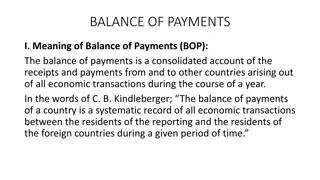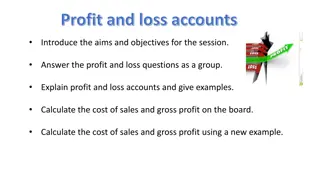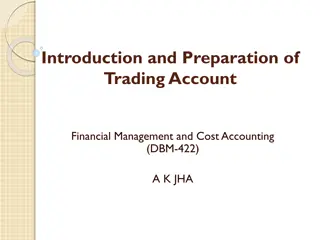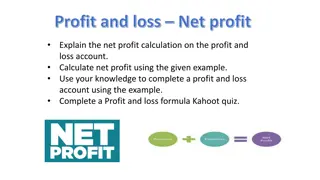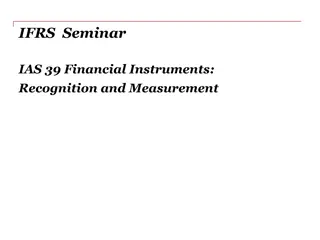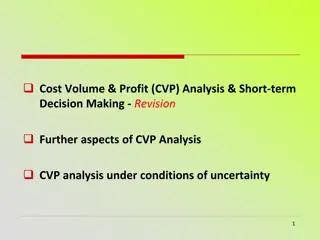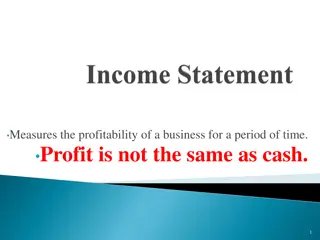Understanding Profit and Loss Account in Financial Management
Profit and Loss Account is a crucial financial statement prepared to determine the net profit or loss of a business during a specific accounting period. It involves transferring gross profit or loss from the trading account, recording indirect expenses, including administrative and selling costs, and calculating the final net profit or loss for the period. The account plays a key role in evaluating the financial performance of a business entity.
Download Presentation

Please find below an Image/Link to download the presentation.
The content on the website is provided AS IS for your information and personal use only. It may not be sold, licensed, or shared on other websites without obtaining consent from the author. Download presentation by click this link. If you encounter any issues during the download, it is possible that the publisher has removed the file from their server.
E N D
Presentation Transcript
Profit and Loss Account Financial Management and Cost Accounting (DBM-422) A K JHA
Profit and Loss Account It is an account prepared to ascertain the net profit or net loss made by a concern during an accounting period. Profit and Loss Account is prepared to estimate the net profit or net loss of the business for a given accounting period. It is prepared after preparing the trading Account.
The Profit and Loss Account starts with the credit from the Trading Account in respect of gross profit or debit if there is gross loss. Then all indirect expenses and losses are debited to the Profit and LossAccount. It means that all those expenses or incomes which have not been debited or credited to the Trading Account are debited or credited in the Profit and LossAccount. Indirect expenses include all administrative, selling and distribution expenses like salaries,rent and taxes, postage, and stationery, insurance, depreciation, interest paid, office lighting, advertising, packing, carriage outwards,etc. Losses include items like loss by fire, loss by theft, etc.
If there is any income and gain beside the gross profit,it will also be transferred to the credit of the Profit and LossAccount. If the total of the credit side exceeds the total of the debit side, the difference represent the net profit. In adverse situation, the difference will represent the net loss. This net profit or net loss is transferred to the capital account of the proprietor. The net profit increases the capital or nt loss reduces the capital.
Format of Profit and Loss Account Dr. Cr. Amount( Rs.) Particulars Particulars Amount(Rs.) To Gross loss transferred from Trading a/c By Gross Profit transferred from Trading a/c To management expenses: By interest received salaries By discount received rent, rates and taxes By commission received stationery and printing charges By Income form investments Telephone expenses By apprenticeship premium legal charges and law costs By rent entertainment expenses By miscellaneous income By net loss transferred to capital account Insurance premium general expenses Audit fees
Format of Profit and Loss Account contd.. Amount (Rs.) Amount(R s.) Particulars Particulars To selling expenses : Advertising salesmen salaries Selling commission Brokerage travelling expenses Free samples Bad debts To Distribution expenses warehouse rent carriage outward warehouse insurance Packing expenses Delivery van expenses
Format of Profit and Loss Account Amount( Rs.) Amount(R s.) Particulars Particulars To Depreciation : Maintenance expenses Depreciation of assets To Finance expenses: Discount on bills Discount allowed Interest on capital Interest on loans Loss by fire To net profit transferred to capital account
Advantages of Profit and Loss Account 1. The net result profit or loss , revealed by this account is an index by which progress can be measured. 2. Various expenses controlled by comparing various expenses, year by year. 3. Profitability is the basis and helps in planning of action. can be effectively
Difference between Trading and Profit and Loss Account TradingAccount Profit and Loss Account 1. The first section of revenue account is trading account. 2. It is prepared to know only the result of trading. 3. It deals with purchasing and manufacturing goods. 4. Balance of this account is transferred to profit and loss account. 1. The revenue account is known as the profit and loss account. 2. It is prepared to know the ultimate result business. 3. It deals with administration, selling, distribution expenses etc. 4. Balance of this account is transferred account. second section of of the costs of to capital









